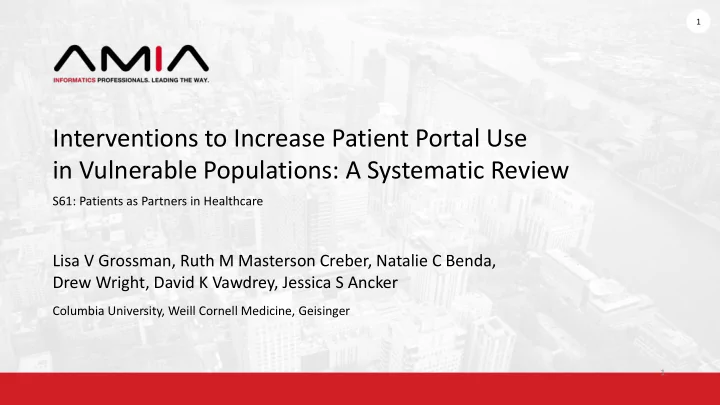

1 Interventions to Increase Patient Portal Use in Vulnerable Populations: A Systematic Review S61: Patients as Partners in Healthcare Lisa V Grossman, Ruth M Masterson Creber, Natalie C Benda, Drew Wright, David K Vawdrey, Jessica S Ancker Columbia University, Weill Cornell Medicine, Geisinger 1
2 Purposes of Patient Portals Patient-provider communication Monitor patient safety concerns Manage medications remotely Collect patient-reported outcomes Medical record verification Communicate costs Develop shared care plans Educate or instruct patients Increase patient satisfaction
3 Portal Use by Year Portal Availability ( ) and Use ( ) in the U.S. Online Refills Messaging Telemedicine 95% 70% Accessible Healthcare 28% 17% Education Medical Records 2014 2017 Symptom Monitoring
4 Disparities in Portal Use Age Race & Ethnicity Socioeconomic status, income Level of education Internet & computer access Functional or health literacy Computer skills Severity of illness Disability status
5 Intervention-Generated Inequity Smoking Rate by Education Level in the U.S. 60% High school Smoking Rate College or higher 40% 20% 0% 1940 1950 1960 1970 1980 1990 2000 2010 Year
6 The Question What interventions could help ensure that portals benefit vulnerable patients?
7
8 Methods
9 Guideline: PRISMA Preferred Reporting Items for Systematic Reviews and Meta-Analyses
10 Eligibility Criteria [PICOS] Populations Vulnerable populations [PROGRESS-Plus] Interventions Any intervention [no limitations] Outcomes (1) Portal use, (2) predictors of portal use, (3) disparities in portal use 1 2 3 Comparisons Any comparison [pre-post, concurrent control, etc.] Study Designs Any design [no limitations]
11 Study Selection Database Search MEDLINE EMBASE CINAHL Cochrane Reviews 1 st Screening 2 nd Screening Included Title & abstract Full text articles In the review Supplemental Search References Personal libraries Journal table-of-contents Author correspondence
12 Data Extraction Objective Measures Design Sample size Intervention Participant characteristics Results Eligibility Criteria Comparison Setting Risk of Bias [AHRQ Methods Guide] Intensity of Intervention [Cochrane Guide]
13 SEIPS Model Task Environment Processes Individual & Outcomes Tool or Technology Organization
14 Results
15 Included Studies 719 studies 91 studies 18 studies Title & abstract Full text Included 15 of 18 [83%] studied impact on portal use 7 of 18 [39%] studied impact on predictors of portal use 1 of 18 [6%] studied impact on disparities in portal use
16 Study Characteristics (n=18) Designs Measures 5 RCTs Login days Clicks 5 Time series Total logins Features viewed 5 Pre-post Activation rates And more! 3 Other Risk of Bias Intensity of Intervention 9 7 5 5 4 3 2 1 Low Medium High Unclear Low Medium High Unclear
17 Intervention Types 1 [6%] Task 2 [11%] Environment e.g., doctors assigning tasks e.g., free access to computers 13 [72%] Individual e.g., training or help registering 5 [28%] Tool or Tech 4 [22%] Organization e.g., updating the portal itself e.g., policy or workflow changes
18 Key Findings: Training How does training and assistance impact portal use in vulnerable populations? 6 # of Studies 1 1 0 Benefit Neutral Mixed Harm Effectiveness
19 Key Findings: Disparities How does a universal access policy impact disparities in portal use? Everyone is offered portal enrollment = Universal Access The policy greatly reduced disparities in portal use.
20 Conclusions
21 The Takeaway Let us move beyond identifying disparities in portal use to start addressing them.
22 Intervention Types Most interventions were individual-level. Weak Actions Strong Actions Task, Tool, = = Individual Environment, Organization one person many people at a time at a time Future interventions should be multi-level.
23 More Takeaways Future studies should measure impact on disparities directly. Standardized measures of portal use could improve comparability
24 Acknowledgments Ruth M Masterson Creber Natalie C Benda Drew Wright David K Vawdrey Jessica S Ancker George Hripcsak Suzanne Bakken Meghan Reading Turchioe Annie Myers
25 https://bit.ly/2Wl4QKS Lisa V Grossman lvg2104@cumc.columbia.edu
Recommend
More recommend